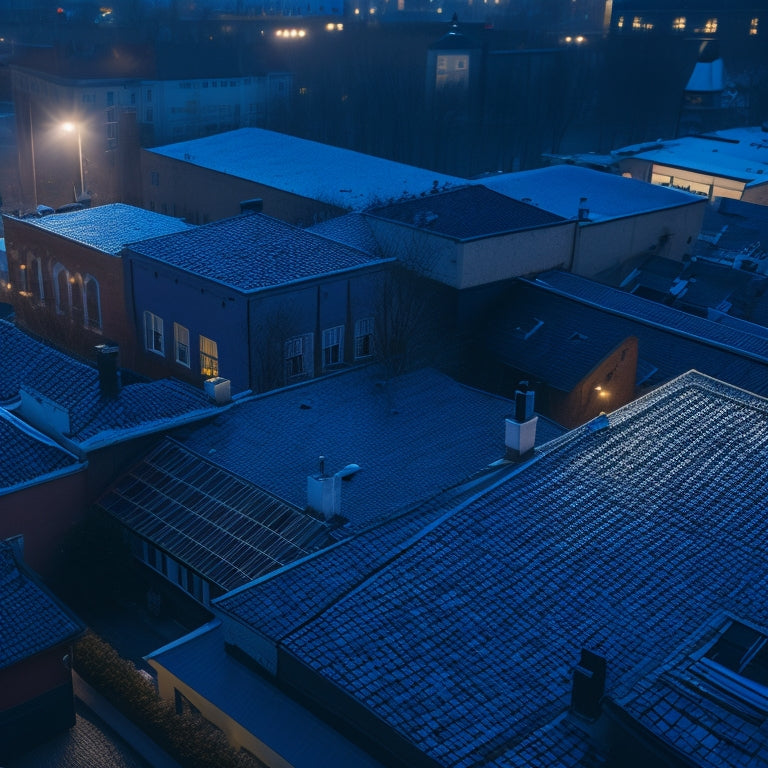
Why Choose Heat-Reflecting Tiles for Your Cool Roof?
Share
By choosing heat-reflecting tiles for your cool roof, you'll greatly reduce energy consumption and contribute to a more sustainable future. These tiles reflect solar radiation, improving thermal performance and reducing the need for cooling, which leads to cost efficiency and resource allocation. Additionally, heat-reflecting tiles mitigate the urban heat island effect, enhance thermal comfort, and support electric vehicles in reducing greenhouse gas emissions. With their durability, weather resistance, and easy installation process, they provide a long-term solution. As you examine this option further, you'll uncover even more benefits that make heat-reflecting tiles an attractive choice for your cool roof.
Key Takeaways
- Heat-reflecting tiles reduce energy consumption and costs by reflecting solar radiation and keeping buildings cooler.
- They mitigate the urban heat island effect, improving thermal comfort and public health in urban areas.
- Durable and weather-resistant, heat-reflecting tiles require minimal maintenance, reducing labor costs and resource allocation.
- Aesthetically versatile, heat-reflecting tiles come in various colors, shapes, and sizes, fitting different design trends and preferences.
- By reducing energy consumption and greenhouse gas emissions, heat-reflecting tiles contribute to a more sustainable and environmentally friendly future.
Heat Reflectivity Explained
Most modern buildings absorb a significant amount of heat from the sun, which can lead to increased energy consumption and higher bills.
You can counteract this by using heat-reflecting tiles on your roof. These tiles work by reflecting solar radiation rather than absorbing it, resulting in improved thermal performance. When solar radiation hits the tile, it bounces back into the atmosphere, keeping your building cooler.
This reduces the amount of heat that enters your building, allowing you to maintain a comfortable temperature while reducing your energy consumption. By optimizing solar panel array design, you can further enhance energy efficiency solar panel optimization.
Additionally, selecting energy-efficient equipment can also contribute to reducing energy losses. By installing heat-reflecting tiles, you're taking an essential step towards creating a more energy-efficient and sustainable building that saves you money and reduces your environmental impact.
Energy Savings Benefits
By installing heat-reflecting tiles, you can markedly reduce the amount of energy needed to cool your building, leading to substantial energy savings. This reduction in energy consumption directly translates to cost efficiency, allowing you to allocate resources elsewhere.
In the long term, these savings add up, providing significant financial benefits. By adopting sustainable practices, such as renewable energy integration, you can further minimize your carbon footprint and enhance energy independence.
Additionally, heat-reflecting tiles can help prolong the life of your roof by reducing thermal stress, further contributing to long term savings. With heat-reflecting tiles, you can enjoy a cooler, more comfortable indoor environment while keeping your energy bills in check.
Reduced Urban Heat Island
You'll find that heat-reflecting tiles can play a significant role in mitigating the urban heat island effect, a phenomenon where built-up areas absorb and retain heat, causing higher temperatures than surrounding rural zones.
As electric vehicles reduce greenhouse gas emissions, heat-reflecting tiles can also contribute to a cleaner urban environment, further enhancing the overall quality of life for city dwellers.
By reducing the temperature of urban surfaces, you can decrease the overall urban temperature, creating a more comfortable environment for city dwellers.
This, in turn, can have a positive impact on local ecosystems and public health.
Heat Island Mitigation
As urban areas sprawl, they trap heat, creating a phenomenon known as the urban heat island effect, where built-up environments absorb and retain more heat than surrounding rural areas.
This issue is further exacerbated by increased vehicle emissions and congestion, which can raise levels of particulate matter in the air air quality and health.
You can mitigate this issue by incorporating heat-reflecting tiles into your cool roof design. This sustainable design approach enhances thermal comfort by reducing the amount of heat absorbed by your building.
By choosing heat-reflecting tiles, you can:
- Reduce the energy required for cooling
- Minimize the urban heat island effect
- Create a more comfortable outdoor environment
- Decrease the strain on your HVAC system
- Contribute to a more sustainable future
Urban Temperature Reduction
Implementing heat-reflecting tiles in cool roof designs greatly reduces urban temperatures, thereby mitigating the urban heat island effect.
You'll experience a significant decrease in ambient air temperatures, creating a more comfortable and livable urban environment.
By incorporating eco-friendly stops with solar canopies and rainwater systems Sustainable Road Trip Amenities, urban cooling is further enhanced.
This urban cooling effect is achieved through effective temperature management, which involves reducing the amount of heat absorbed by buildings and infrastructure.
By installing heat-reflecting tiles, you're not only reducing the urban heat island effect but also decreasing the strain on your building's cooling systems.
This results in energy savings and a reduced carbon footprint.
With heat-reflecting tiles, you can enjoy a cooler, more sustainable urban space that promotes freedom and well-being.
Durability and Longevity
When you're investing in heat-reflecting tiles, you expect them to withstand the elements and perform well over time.
Weather resistance matters, and you should look for tiles that can assure lasting performance even in harsh conditions.
Weather Resistance Matters
How do heat-reflecting tiles withstand the harsh outdoor environment where they're constantly exposed to various weather conditions? You need tiles that can resist the elements, ensuring your cool roof remains efficient and durable.
Heat-reflecting tiles are designed with weather resistance in mind, offering:
-
Moisture protection: preventing water infiltration and reducing the risk of water damage
-
UV resistance: withstanding the harsh effects of ultraviolet rays, which can cause degradation over time
-
High-temperature tolerance: performing well in extreme heat, maintaining their reflective properties
-
Wind and hail resistance: withstanding strong winds and hailstorms without compromising their structure
-
Chemical resistance: resisting corrosion from environmental pollutants and chemicals
Lasting Performance Guaranteed
With heat-reflecting tiles that can withstand the harshest weather conditions, you can now focus on the long-term benefits they provide.
You'll enjoy a lasting performance that reduces maintenance requirements and saves you money in the long run. Since heat-reflecting tiles are built to last, you won't need to worry about frequent replacements, which means lower installation costs over time.
This means you can allocate your resources to other important aspects of your life, giving you the freedom to pursue your goals and aspirations.
With heat-reflecting tiles, you can rest assured that your cool roof will continue to perform effectively for years to come, providing you with a sense of security and peace of mind.
Withstands Harsh Conditions
Harsh weather conditions, including intense sunlight, heavy rainfall, and extreme temperature fluctuations, are no match for heat-reflecting tiles. You can rest assured that these tiles will withstand the toughest environments, maintaining their reflective properties and energy-saving benefits.
-
They're designed to accommodate thermal expansion, ensuring a secure fit and preventing cracks.
-
Their moisture resistance prevents water from seeping beneath the surface, reducing the risk of damage and decay.
-
They're resistant to extreme temperatures, from scorching heat to freezing cold.
-
They can withstand heavy rainfall and high winds without compromising their structure.
-
They're built to last, with a long lifespan that reduces the need for frequent replacements.
Easy Installation Process
You'll find that the heat-reflecting tiles for cool roofs come with a streamlined installation process, requiring minimal labor and skill. This means you can save time and money on labor costs, allowing you to allocate resources to other important aspects of your project.
The tiles are designed for easy application, and you can follow simple installation tips to guarantee a successful outcome. Typically, the application methods involve a peel-and-stick process or a mechanical fastening system, making it easy to install the tiles even on complex roof shapes.
With the right tools and a bit of planning, you can complete the installation quickly and efficiently, giving you the freedom to focus on other aspects of your project.
Aesthetic Versatility Options
As you've streamlined the installation process, you can now focus on the aesthetic aspects of your cool roof project.
With heat-reflecting tiles, you have the freedom to investigate various design options that align with your personal style and design vision.
- Choose from a wide range of colors to create a unique color palette that complements your building's exterior
- Select from various tile shapes and sizes to create a visually appealing pattern
- Mix and match different tile styles to create a one-of-a-kind design
- Consider incorporating natural materials, like wood or stone, to add texture and depth
- Stay on-trend with the latest design trends, from modern and sleek to traditional and rustic
Environmental Impact Reduction
Frequently, building owners and designers overlook the environmental implications of their roofing choices, but not with heat-reflecting tiles.
You can markedly reduce your building's ecological footprint by opting for these tiles. Made from sustainable materials, they minimize waste and conserve natural resources.
Heat-reflecting tiles also play an essential role in climate adaptation by reducing the urban heat island effect. By reflecting solar radiation, they lower the surrounding temperature, decreasing the need for air conditioning and the subsequent energy consumption.
This, in turn, reduces greenhouse gas emissions and mitigates the impact of climate change. By choosing heat-reflecting tiles, you're not only creating a cooler roof but also contributing to a more environmentally friendly and sustainable future.
Frequently Asked Questions
Can Heat-Reflecting Tiles Be Used on Existing Roofs or New Constructions Only?
You can install heat-reflecting tiles on both existing roofs through roof retrofitting and new constructions, offering flexible installation options that cater to your needs, providing freedom to choose the best approach for your building project.
Are Heat-Reflecting Tiles Compatible With All Types of Roofing Materials?
As you commence on your roofing expedition, you'll find heat-reflecting tiles harmonize with most materials, but you'll need to contemplate installation subtleties, ensuring a harmony of material compatibility, to reveal the full potential of your cool roof haven.
How Do Heat-Reflecting Tiles Perform in Extreme Weather Conditions?
You'll find that heat-reflecting tiles excel in extreme weather conditions, showcasing exceptional thermal performance and weather resilience, as they're designed to withstand scorching heat, torrential rains, and intense winds, ensuring your roof remains stable and efficient.
Can Heat-Reflecting Tiles Be Walked on or Are They Fragile?
When you're considering heat-reflecting tiles, you're likely wondering if they can withstand foot traffic; rest assured, they're designed to be durable, but it's essential to follow installation guidelines to alleviate durability concerns and guarantee a secure, long-lasting surface.
Do Heat-Reflecting Tiles Require Special Maintenance or Cleaning?
You'll find heat-reflecting tiles require minimal maintenance, with occasional gentle cleaning using soft-bristled brushes and mild detergents; maintenance frequency depends on environmental factors, but typically you'll need to clean them every 6-12 months using specialized cleaning techniques.
Related Posts
-

3 Ways Wind Power Boosts Home Value
Living near a wind farm can enhance your property's value in three significant ways. To begin with, proximity to wind...
-

3 Earth-Loving Furniture Tips for Energy-Smart Homes
When furnishing your energy-smart home, you have the power to reduce your carbon footprint greatly by making consciou...
-

Why Choose Solar Composting Toilets for Your Home?
By choosing a solar composting toilet for your home, you'll greatly reduce your environmental impact, slashing your w...


